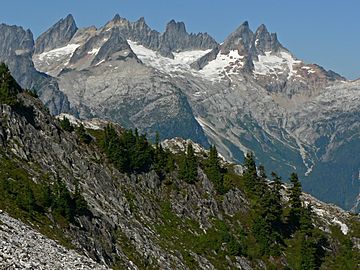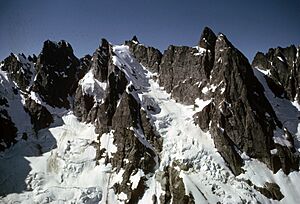Mount Degenhardt facts for kids
Quick facts for kids Mount Degenhardt |
|
|---|---|

In background left to right, Mouth Terror, Mount Degenhardt, The Pyramid, Inspiration Peak and the McMillan Spires
|
|
| Highest point | |
| Elevation | 8,000+ ft (2,440+ m) |
| Prominence | 280 ft (90 m) |
| Geography | |
| Location | Whatcom County, Washington, U.S. |
| Parent range | Cascade Range |
| Topo map | USGS Mount Challenger |
| Climbing | |
| First ascent | 1931 by William Degenhardt and Herbert Strandberg |
Mount Degenhardt is a tall mountain peak in the Picket Range in Washington, USA. It's part of the beautiful North Cascades National Park. This mountain stands about 8,000 feet (2,438 meters) high. It's located in the northern part of the park, close to other peaks like Mount Terror and Inspiration Peak. Mount Degenhardt is named after William Degenhardt, who was an important mountain climber in the early 1900s. The Terror Glacier can be found on the mountain's southeast side. The first time someone successfully climbed Mount Degenhardt was in 1931, by William Degenhardt and Herbert Strandberg.
Weather Around Mount Degenhardt
Mount Degenhardt is in a special climate zone called the marine west coast climate. This means it's near the Pacific Ocean, which affects its weather a lot. Most of the weather systems start over the Pacific Ocean and move towards the Cascade Mountains.
When these weather systems reach the North Cascades, the tall mountains force the air to rise. As the air goes higher, it cools down and drops its moisture as rain or snow. This is why the western side of the North Cascades gets a lot of rain and snow, especially in winter.
- Winters are usually cloudy with lots of snow.
- Summers often have clear skies because of high-pressure systems over the Pacific Ocean.
- Temperatures rarely go below 0°F (–18°C) or above 80°F (27°C) in areas west of the main mountain crest.
- Because of the ocean's influence, the snow here is often wet and heavy. This can lead to a high risk of avalanches.
How the Mountains Were Formed
The North Cascades area has some of the most rugged and dramatic landscapes in the Cascade Range. You can see sharp peaks, long ridges, and deep valleys carved by glaciers. These amazing features were created by geological events that happened millions of years ago. These events also caused the big changes in elevation and the different climates you see across the Cascade Range.
The Cascade Mountains started forming millions of years ago, during a time called the late Eocene Epoch. This happened because the North American Plate (a huge piece of Earth's crust) was slowly moving over the Pacific Plate. This movement caused a lot of volcanic activity.
Also, small pieces of Earth's crust, called terranes, came together to form the North Cascades about 50 million years ago.
During the Pleistocene period, which was over two million years ago, huge sheets of ice called glaciers moved across the land many times. As they advanced and retreated, they carved out the landscape and left behind piles of rock. The river valleys in this area have a "U" shape, which is a clear sign that glaciers once moved through them. The combination of land being pushed up (called uplift) and cracks in the Earth's crust (called faulting), along with the action of glaciers, created the tall peaks and deep valleys we see in the North Cascades today.




